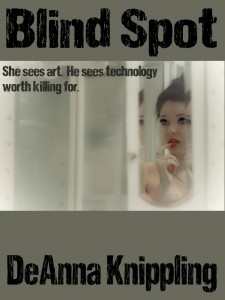Now at Smashwords, Amazon, Barnes & Noble, and OmniLit.
Try to catch the Smashwords free coupon code out of the corner of your eye….there it is: VD39W. This weekend only.
DeAnna Knippling
She sees art. He sees technology worth killing for.
An artist who sees what nobody else sees: the visual code generated by the eye’s own blind spot. A VR developer who sees the possiblities–including the threat to her life.
“I can’t see myself,” Thomas said, raising his hand to touch the Mirror. The reflected room behind him was pale gray and filled with a line of guests, each craning their necks to see around him. It was a terrible sight, and he smiled in delight even as his eyes filled with tears. His body grieved for the lack of himself, the knowledge of how little he mattered, even as he felt like crowing with joy.
“Sir.” The guard shook his head. “Don’t touch.” He’d been saying it through the whole opening, no doubt, to incredulous guests trying to touch the work of art or science or whatever it was. Keeping people far back enough from the frame so they didn’t spill wine on it when it clicked.
“How?” Thomas asked, knowing that the guard couldn’t answer the question, but unable to stop himself.
“Read the sign, sir,” the guard said.
Thomas laughed under his breath. It wasn’t what he’d wanted to know, but he bent toward the sign anyway; he would have seemed out of place otherwise.
Why can’t you see yourself in “The Mirror of the World without You”?
The sign explained, in language a ten-year-old could understand, that it wasn’t a mirror but a television. Cameras in the television screen itself—which had originally been part of a console gaming system—recorded the images that surrounded the screen and projected them.
The real trick was in the way the cameras removed the viewer’s image from the screen. The cameras didn’t just edit out the image of the viewer—which would have removed all people from the image—but placed a subtle pattern layer over all moving objects. The pattern was cued to align with the orientation of the eyes of each object, if it had any, and simulated the sensory data the eyes sent to the brain from the area directly over the optic nerve, or blind spot.
The brain saw the pattern, interpreted it as the eye’s blind spot, and filled it in with what it calculated to be the correct images. The brain, trained to compensate for its own shortcomings, erased anything coded with what seemed to be the same pattern, rendering it invisible.
It was essentially an optical illusion, if a very sophisticated one. It worked wonderfully. As Thomas finished reading the sign, he peeked at the Mirror out of the corner of his eye, trying to get a glimpse of himself. The cameras tracked his gaze quickly, but he was able to catch a white wisp that faded like a breath on glass. It was creepy.
The woman behind him was having a completely different reaction. She was standing with her hands on her hips and grinning, making faces at herself. “Nobody can see me! I can do whatever I want! Nyaaa!” She stuck her tongue out.
But of course Thomas and the other guests could still see her, both in real life and in the mirror; each person only failed to see themselves.


